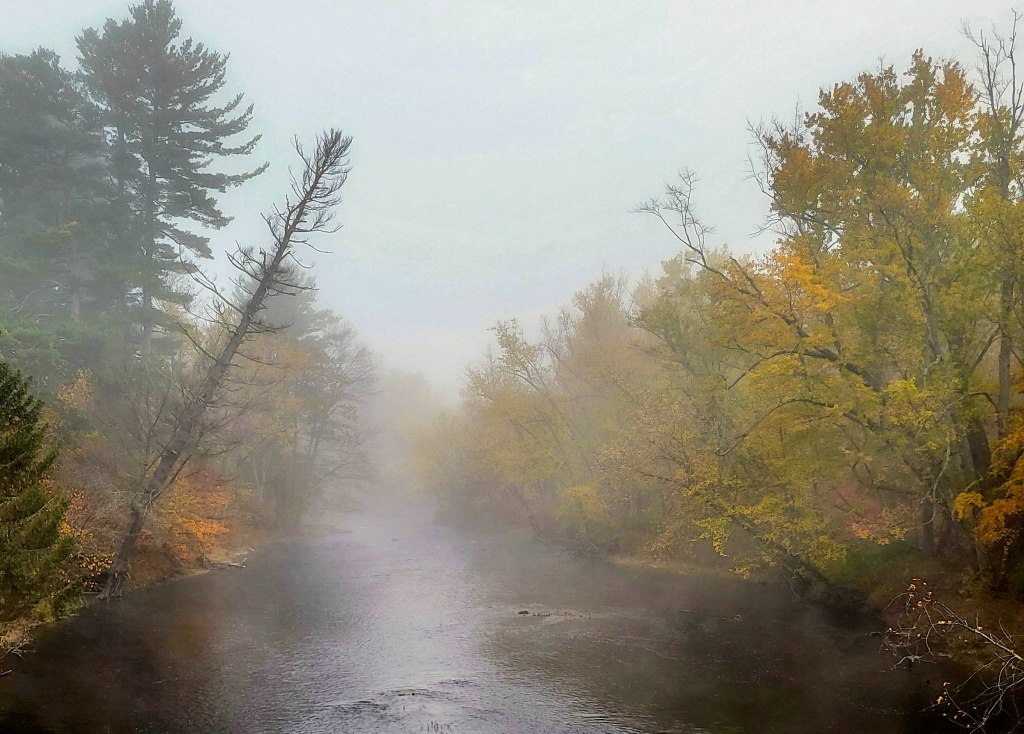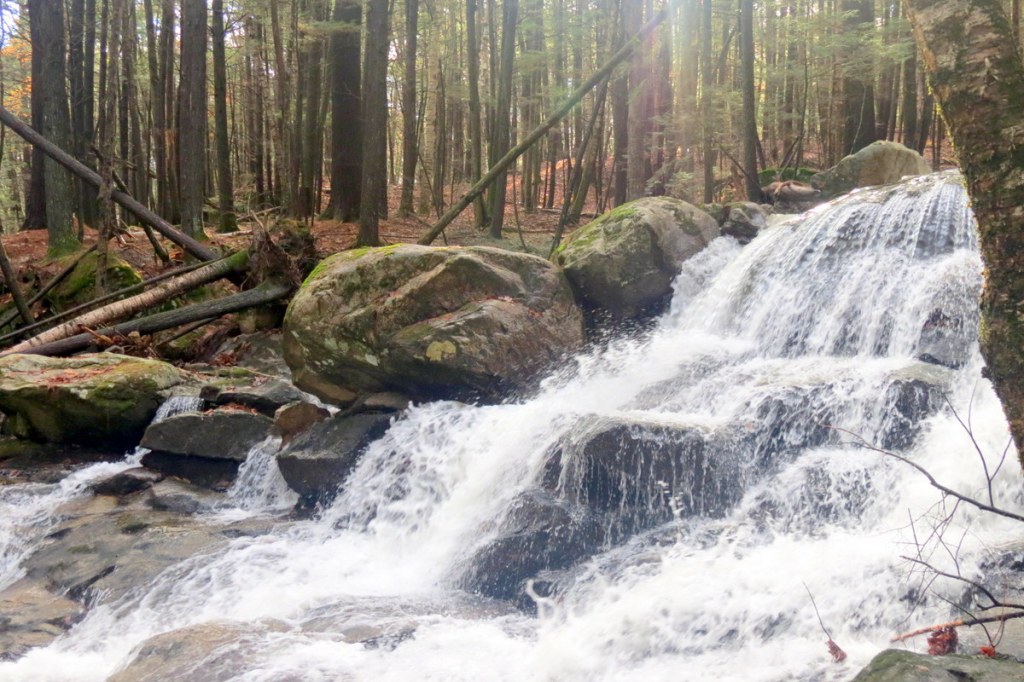
This post was going to be about the beeches and oaks at Willard Pond in Antrim. For years now I’ve finished the foliage season by visiting this beautiful hardwood forest but this year the light just wasn’t with me on my first visit. This photo has been lightened somewhat so it doesn’t show how dark it really was, especially under the trees. Shooting photos in such conditions would have been a waste of time so I turned and left.

A week later on Halloween I returned to Willard Pond on a cold, blustery morning to find that most of the leaves had fallen. I thought this was a bit odd since Halloween has always been my time to visit but the weather has been strange and unpredictable for all of this year. To be truthful I wasn’t upset that there would be no Willard Pond post this year because the Tudor trail that I usually follow is one of the roughest I know, with a lot of boulders and other things to step over and around. Each time I went I followed the trail for a short while and found that it bothered the knee that I damaged in my recent fall on Pitcher Mountain, so skipping it this year will probably turn out to be the right decision. If you want to see what Willard Pond Forest is like just go up to the search box at the top of the page and type “Willard Pond.” You’ll find several years of posts.

On the road into Willard Pond I saw some beautiful maple leaved viburnums on the side of the road. The color range of these plants is really amazing.

I also saw some bright red winterberries at Willard Pond. The fruits of this native holly hold their color for quite a while so they are sought after by people wanting to use them for holiday decorations. I often find bushes that have had almost all the berry bearing branches cut off.

I think for a while due to leg pain and maybe some balance issues that I should stay on flat, level surfaces like this rail trail in Keene. Other than an occasional woodchuck hole there is little to trip over as long as you stay on the trail. This will not be a hardship because I grew up on this trail way back when it was a working railroad route and I know it as well as I know myself. On this day I went to see the tree colors, which were a bit muted.

The muted colors come naturally because I think there are mostly silver maples in this area. Silver maples turn different shades of yellow in the fall unlike red maples, which have a much wider color range including red and orange.

Though there are still a few isolated red maples showing color most now look like this one.

All the yellow seen in this view comes from beeches, silver maples, birches, and Japanese honeysuckles.

Even the deer tongue grasses turned yellow this year. Quite often I see a lot of purple on these plants.

The silvery, fluffy seedheads of virgin’s bower vines line the rail trail. When in flower they’re known as traveler’s joy but at this stage they’re called Devil’s darning needles. Both names are just meaningless labels we’ve put on a pretty plant. The truth is, in nature there is no good or bad, no right or wrong, no past or future; there is just the perfection of this moment called now. We would do well to learn from this.

In a college botany class I once had I did my final exam paper on poisonous plants. The plant seen here was one of the deadliest, but also one of the most interesting. It is monk’s hood or monkshood; Queen of poisons, and it has been used to kill for countless centuries. If you were found growing it in ancient Rome there was a good chance that you’d be put to death, because as far as the Romans were concerned the only use for the extremely toxic plant was to add its toxic sap to the water of one’s enemies to eliminate them.

A side view of the flowers shows where the name monk’s hood comes from. The plant is in the aconite family and its sap can be absorbed through the skin. In 2015 an experienced gardener in the U.K. died of multiple organ failure after weeding and hoeing near aconite plants. I will often hold a plant steady with one hand while taking a photo with the other hand on windy days but not this plant.
Monkshood plants can stand a lot of cold so it is often one of the last to bloom in this area. The flowers are quite unusual and very pretty but it should only be grown where there are no children present, in my opinion. Knowledge of its dangers and always working around it with gloves on means anyone can grow it. If you do it will certainly be a conversation starter. Just think, you could tell friends how the Roman Agrippina hired Locusta to poison the emperor Claudius I in 54 AD. It is said that Locusta chose aconite to do the deed.

I saw some oak leaves with odd patterns on them. Whether made by insects or caused by nutrient deficiency, I don’t know. There is an insect, a leaf miner I think, which eats all the soft tissue of an oak leaf, leaving just the ribs and a net like skeleton leaf behind.

Some of these photos weren’t used in other posts for whatever reason. One of them is this misty morning visit to the wetlands when the maples were still colorful.

I saw more dewy spider webs on that visit. It’s hard to believe how many large webs are in these trees. This one was about the size of a basketball and I’d say on average that would be the size of most of them.

The colors have been beautiful this year but they’ve also been drawn out because of the warm weather. Everyone I meet seems to have an opinion about what a strange year it has been weather-wise.

The staghorn sumac colors have been amazing this year. The reds especially have been intense. Red is often a tough color for cameras to reproduce accurately but I think this is a fair representation.

Except for the deep purples of ash and oak I can’t think of a single fall leaf color that isn’t represented here in this scene from the wetlands. They’re all there and how beautiful they are when they’re all together in this way. It can take your breath away sometimes.

This is another scene from the wetlands that I like very much. All summer long I thought it would be beautiful in the fall because of the maples, and it was.

In the past the photos I’ve taken of poplars (Aspens) in the fall have almost always been soft and impressionistic as if they had been drawn with pastels, but these trees in the foreground seemed a bit loud to me. In shape and in leaf color poplars look a lot like birches from a distance. Only the gray bark tells the story. Most birches in this area growing in large colonies like that seen here are gray birches, which have white bark.

This is why I call this place the wetlands. The road I walk on was built through a swamp and there is water all along the roadsides. There is abundant life in a swamp and this is an excellent way to stay dry while seeing it.

I’m not sure where else I’d see autumn meadowhawks still flying in November. They were everywhere yesterday, resting in the sunshine. This one landed on a stump right in front of me and I had to wonder if they could read minds. I also saw lots of bluebirds on this day but I couldn’t get any of them to pose.

I was surprised to see a few pickerel weed flowers blooming in the wetlands after all others in various places had gone to seed. I have to say that this spot is a real jewel, with an abundance of birds, animals, insects, and interesting plants and wildflowers. There’s really no telling what you’ll see on any given day and I’m very happy to have finally discovered it, right there alongside the Keene Airport of all places. The level, paved road is easy to walk but there are plenty of places where you can leave it and explore the forest.

It was there in the wetlands that I saw the fall colors of tall meadow rue for the first time. This plant always blooms just at or before July 4th with flowers that look like bursts of fireworks. The “tall” part of its common name is very true; I’ve seen it reach over seven feet.

Since we had snow flurries as I was writing parts of this post I’ll end it with a white aster. We’ve also had our first freeze, almost a month late and coming before the first frost that should have happened in mid-September. Oh well, since a friend in Michigan reported 10 inches of snow on Halloween I don’t think we have anything to complain about.
An autumn forest is such a place that once entered you never look for the exit. ~Mehmet Murat ildan
Thanks for coming by.























































































































































































































